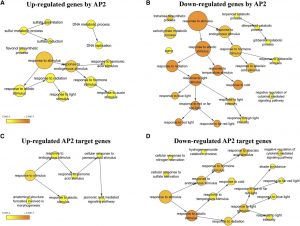On the Inside: APETALA-2 and Meristem Arrest
 The number of flowers that an inflorescence is able to produce, and therefore the number of fruits and seeds, depends on the activity of the shoot apical meristem (SAM) and the length of the flowering period. In monocarpic plants, the end of flowering is associated with a senescence process called global proliferative arrest (GPA). GPA has been well characterized in Arabidopsis (Arabidopsis thaliana), starting with the arrest of SAM in the main inflorescence following the production of a certain number of flowers. At this point, all the active meristems of the plant also arrest more or less synchronously, responding to both local and systemic cues. After meristem arrest, the plant completes the filling of the last seeds produced and enters a global senescence that ends with the death of the plant. The initiation of GPA is clearly affected by seed production and development. Sterile mutants or plants where flowers are removed manually show a delayed GPA, which leads to an increase in the flowers produced by the SAM. It has been proposed that the meristems that undergo arrest at the end of the reproductive phase behave at the transcriptomic level as dormant meristems, with low mitotic activity and high expression of abscisic acid response genes. Meristem arrest is also controlled genetically. In Arabidopsis, the transcription factor FRUITFULL induces GPA by directly repressing genes of the APETALA2 (AP2) clade. The AP2 genes maintain SAM activity in part by keeping WUSCHEL expression active, but the mechanisms downstream of this pathway remain elusive. To identify target genes, Martinez-Fernandez et al. (10.1104/pp.20.00800) performed a transcriptomic analysis, inducing AP2 activity in meristems close to arrest. Their results, in combination with previous reports, indicate that AP2 controls meristem activity and GPA via two main hormonal responses, ABA and cytokinins (CK), as well as by regulating genes that respond to different environmental signals, such as light quality and temperature.
The number of flowers that an inflorescence is able to produce, and therefore the number of fruits and seeds, depends on the activity of the shoot apical meristem (SAM) and the length of the flowering period. In monocarpic plants, the end of flowering is associated with a senescence process called global proliferative arrest (GPA). GPA has been well characterized in Arabidopsis (Arabidopsis thaliana), starting with the arrest of SAM in the main inflorescence following the production of a certain number of flowers. At this point, all the active meristems of the plant also arrest more or less synchronously, responding to both local and systemic cues. After meristem arrest, the plant completes the filling of the last seeds produced and enters a global senescence that ends with the death of the plant. The initiation of GPA is clearly affected by seed production and development. Sterile mutants or plants where flowers are removed manually show a delayed GPA, which leads to an increase in the flowers produced by the SAM. It has been proposed that the meristems that undergo arrest at the end of the reproductive phase behave at the transcriptomic level as dormant meristems, with low mitotic activity and high expression of abscisic acid response genes. Meristem arrest is also controlled genetically. In Arabidopsis, the transcription factor FRUITFULL induces GPA by directly repressing genes of the APETALA2 (AP2) clade. The AP2 genes maintain SAM activity in part by keeping WUSCHEL expression active, but the mechanisms downstream of this pathway remain elusive. To identify target genes, Martinez-Fernandez et al. (10.1104/pp.20.00800) performed a transcriptomic analysis, inducing AP2 activity in meristems close to arrest. Their results, in combination with previous reports, indicate that AP2 controls meristem activity and GPA via two main hormonal responses, ABA and cytokinins (CK), as well as by regulating genes that respond to different environmental signals, such as light quality and temperature.



